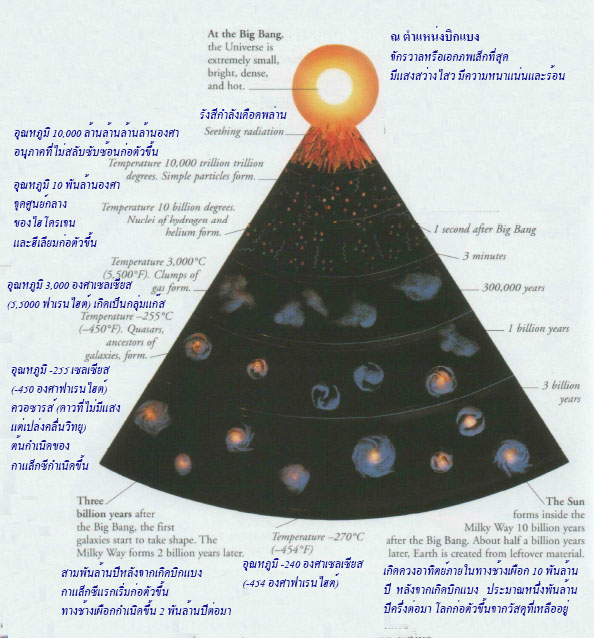BIG BANG
AN INCREDIBLE
EXPLOSION called the Big Bang is believed to have
created the Universe. Observations
of galaxies and heat radiation from space have helped confirm this theory. Astronomers
are now working to explain exactly what happened from the point of the Big Bang explosion which created everything in today's Universe — matter,
energy, space, and time - to the
present Universe with its galaxies, stars, planets, and
us.
|
การระเบิดครั้งยิ่งใหญ่
(BIG
BANG)
การระเบิดอันเหลือเชื่อ
ซึ่งเรียกว่า บิกแบง เชื่อกันว่าก่อให้เกิดจักรวาล การสังเกตกาแล็กซีและรังสีความร้อนจากอวกาศช่วยยืนยันทฤษฎีนี้
นักดาราศาสตร์ในปัจจุบันกำลังอธิบายให้ชัดเจนว่ามีเหตุอะไรเกิดขึ้นจากจุดระเบิดบิกแบง
ซึ่งสร้างทุกสิ่งทุกอย่างในจักรวาลในทุกวันนี้ คือ มวลสาร พลังงาน อวกาศ และเวลา
เพื่อนำมาแสดงจักรวาลด้วยกาแล็กซี ดาวฤกษ์ ดาวเคราะห์และพวกเรา
|
|
Origin of the
Universe
One of the most
difficult problems facing scientists in the 20th century
was to explain how the Universe was created. The Universe is changing, but from what and to what? The Steady State theory suggested that the Universe had no beginning or end. The alternative, and now generally
accepted, theory is the Big Bang. It
proposes that the Universe was created in an explosion
15 billion years ago. From very small and simple beginnings it has grown vast and complex.
|
กำเนิดจักรวาล (หรือเอกภพ)
ปัญหาที่ยุ่งยากที่สุดอย่างหนึ่งที่นักวิทยาศาสตร์เผชิญในศตวรรษที่
20 คือการอธิบายว่าจักรวาลเกิดมาได้อย่างไร จักรวาลกำลังเปลี่ยนแปลง
แต่เปลี่ยนแปลงจากอะไร? และเปลี่ยนแปลไปเป็นอะไร? ทฤษฎีสภาวะคงที่ เสนอว่า
จักรวาลไม่มีจุดเริ่มต้นและไม่มีจุดสิ้นสุด ทฤษฎีทางเลือก และทฤษฎีที่ยอมรับกันในปัจจุบันนี้
คือ ทฤษฎีบิกแบง ทฤษฎีนี้เสนอว่า
จักรวาลเกิดขึ้นจากการระเบิดเมื่อสิบห้าพันล้านปีที่ผ่านมา
เริ่มจากจุดกำเนิดเล็ก ๆ และง่าย ๆ กลายเป็นวิวัฒนาการใหญ่โตมหึมาและสลับซับซ้อน
|
|
|
|
||
Big Bang theory
All matter and time
was created in the Big Bang. The
explosion started pushing everything away and the
Universe has been expanding ever since; and as the
Universe expanded, the temperature dropped.
A fraction of a second after the explosion, the first tiny particles began to form. By
the time the Universe was three minutes old, it consisted of 75 per cent hydrogen and 25
per cent helium. Everything that exists
now - galaxies, stars, Earth, and
humans - was created from these
elements.
|
ทฤษฎีบิกแบง
มวลสารทั้งหมดและกาลเวลาถูกสร้างขึ้นในบิกแบง
การระเบิดเริ่มผลักดันทุกสิ่งทุกอย่างออกจากกันและจักรวาลก็กำลังขยายออกไปเรื่อย
ๆ และในขณะที่จักรวาลขยายออก อุณหภูมิก็ลดลง เศษส่วนเล็ก ๆ ของ 1 วินาที
หลังจากระเบิด
ซึ่งเป็นอนุภาคที่เล็กกระจิริดชิ้นแรกเริ่มจะก่อตัวขึ้นเป็นรูปร่าง เมื่อเวลาผ่านไปจักรวาลก็มีอายุ
3 นาที มันประกอบด้วยก๊าซไฮโดรเจน 75 เปอร์เซ็นต์และก๊าซฮีเลียม 25 เปอร์เซ็นต์ ทุกสิ่งทุกอย่างซึ่งเกิดขึ้นมาในขณะนั้น
คือ กาแล็กซี ดาวฤกษ์ โลก และมนุษย์ ก็ถูกสร้างมาจากธาตุเหล่านี้
|
|
A Steady-State
universe now (left) and later in time
(right). The galaxies
have moved apart, but new ones (coded orange)
have been created to take their place.
The density stays the same.
ขณะนั้นจักรวาลอยู่ในสภาวะคงที่ (ภาพซ้าย)
และต่อมาก็ขึ้นอยู่กับกาลเวลา (ภาพขวา) กาแล็กซีเคลื่อนออกจากกัน แต่มีจักรวาลใหม่
ๆ (สัญลักษณ์สีส้ม) เกิดขึ้นมาแทนที่ ความหนาแน่นก็ยังคงอยู่เหมือนเดิม
|
|||
Steady State theory
In the late 1940s and
the 1950s, the Steady State theory was as popular as the
Big Bang theory. It proposed that the
Universe looked the same at any place and at any time. Although
expanding, it would stay unchanged and in perfect balance. Material was being continuously created to keep the density of the Universe constant. As
scientists found proof for the Big Bang, the Steady
State theory was largely abandoned.
|
ทฤษฎีสภาวะคงที่
เมื่อปลายทศวรรษที่
1940 ถึงปลายทศวรรษที่ 1950 ทฤษฎีสภาวะคงที่ได้รับความนิยมพอ ๆ กับทฤษฎีบิกแบง ทฤษฎีนี้เสนอว่า
จักรวาลดูเหมือนจะคงที่ไม่ว่าในที่ใดและเวลาใด แม้ว่าจะขยายออก
มันก็ไม่มีการเปลี่ยนแปลงและอยู่ในความสมดุลโดยสมบูรณ์ มวลสารก็กำลังเกิดขึ้นอยู่เรื่อย
ๆ เพื่อรักษาความหนาแน่นของจักรวาลให้คงที่ เนื่องจากนักวิทยาศาสตร์พิสูจน์ทฤษฎีบิกแบง
ทฤษฎีสภาวะคงที่จึงถูกทอดทิ้งเป็นส่วนใหญ่
|
Georges Lemaitre
In 1931, Belgian
cosmologist Georges Lemaitre (1894-1966) was the first to put
forward the theory that the Universe started from a
dense, single unit of material in a big explosion. The name Big Bang followed in 1950,
introduced by Fred Hoyle, a British astronomer and supporter of the Steady State theory.
|
ฌอร์ฌ เลอแม็ทร์
ในปี
ค.ศ. 1931 (พ.ศ. 2474) ฌอร์ฌ เลอแม็ทร์ ผู้รอบรู้ในเรื่องจักรวาลชาวเบลเยียม
(มีชีวิตอยู่ระหว่าง ค.ศ. 1894 – 1966 = พ.ศ. 2437 – 2509 อายุ 72 ปี) เป็นคนแรกที่เสนอทฤษฎีว่า
จักรวาล (ดาราจักร)
เริ่มจากความหนาแน่นเป็นมวลสารหน่วยเดียวในการระเบิดครั้งยิ่งใหญ่ ชื่อบิกแบงนำมาใช้กันในปี
ค.ศ. 1950 (พ.ศ. 2493) ซึ่งเริ่มนำมาใช้โดยเฟรด
ฮอยล์ นักดาราศาสตร์ชาวอังกฤษและเป็นผู้สนับสนุนทฤษฎีสภาวะคงที่
(เขาเอาคำว่า บิกแบง มาล้อเลียนทฤษฎีของเลอแม็ทร์)
|
Expanding Universe
In the 1920s,
analysing starlight from galaxies showed that the galaxies are moving away from Earth. This is true of galaxies in every
direction from Earth. Over time,
the Universe is becoming larger and less dense. The idea that the Universe started in
an explosion from a single point grew
out of observations that the Universe is expanding.
|
จักรวาลขยายตัว
ในศตวรรษที่
1920 การศึกษาแสงดวงดาวจากกาแล็กซีแสดงให้เห็นว่า กาแล็กซีกำลังเคลื่อนออกไปจากโลก
ข้อนี้เป็นความจริงของกาแล็กซีในทุกทิศทางจากโลก เมื่อเวลาผ่านไป
จักรวาลก็ใหญ่ขึ้นและมีความหนาแน่นน้อยลง ความคิดที่ว่าจักรวาลเริ่มระเบิดจากจุดเดียวโดด
ๆ มีพัฒนาการมาจากการสังเกตเห็นว่าจักรวาลกำลังขยาย
|
|||
|
|
||||
Background radiation
The heat produced by
the Big Bang has been cooling ever since. It
now has a temperature of-270°C (-454°F), detected as microwave radiation from
all over the sky. The false-colour
map shows variations in the temperature 300,000 years
after the Big Bang. The blue (cooler) patches are gas clouds, from which the galaxies formed.
|
รังสีที่อยู่เบื้องหลัง
ความร้อนที่เกิดจากบิกแบงกำลังเย็นลงเรื่อย
ๆ ปัจจุบันมีอุณหภูมิ -270 องศาเซลเซียส (-454 องศาฟาเรนไฮต์) ตรวจจับในขณะที่รังสีไมโครเวฟกระจายไปทั่วท้องฟ้า
แผนที่ที่เป็นสีทำขึ้นมาแสดงให้เห็นว่ารังสีในอุณหภูมิเมื่อ 300,000
ปีหลังจากเกิดบิกแบง รอยปะสีฟ้า (เป็นสีที่เย็นตา) คือก้อนเมฆที่เป็นกลุ่มก๊าซ ซึ่งจะก่อตัวเป็นกาแล็กซี
|
Redshift: The faster a galaxy is
moving away, the more the wavelength
of its starlight is stretched, or redshifted.
|
การเปลี่ยนความยาวคลื่นของคลื่นแสง: กาแล็กซีเคลื่อนออกไปเร็วขึ้น
ๆ ความยาวคลื่นของแสงดวงดาวก็ขยายเหยียดออกมากขึ้น หรือเปลี่ยนเป็นความยาวคลื่นของคลื่นแสง
|
|
|
Future of the Universe
Nobody knows for
certain what is going to happen to the Universe. At present, it is getting larger and less
dense. Most astronomers believe
there will be a time when it stops expanding. But there is disagreement about, what
happens then: will the Universe
live on for ever, wither and die,
or start to contract?
|
|
อนาคตของจักรวาล
ไม่มีใครรู้อย่างแน่นอนว่าอะไรกำลังจะเกิดขึ้นกับจักรวาล
ในปัจจุบันมันกำลังขยายใหญ่ขึ้น ๆ และมีความหนาแน่นน้อยลง ๆ
นักดาราศาสตร์ส่วนใหญ่เชื่อว่าน่าจะมีช่วงเวลาที่จักรวาลจะหยุดขยายตัว แต่ก็มีผู้ไม่เห็นด้วย
แล้วจะเกิดอะไรขึ้น: จักรวาลจะยังคงอยู่ตลอดไปหรือไม่
หรือจะสิ้นสุดลง หรือจะเริ่มหดตัว?
|
|
Big Crunch
The Universe may end
in a Big Crunch if it starts to contract until it is hot
and dense once more. But even this
may not mean the end of the Universe. The
Big Crunch might be followed by another Big Bang
explosion, and the whole process could start over again.
บิกครันช์ (Big Crunch)
จักรวาลอาจจะสิ้นสุดลงในบิกครันช์
(คำว่า crunch
แปลว่า เคี้ยวดังกร้วม ๆ ทำนองจักรวาลคงคล้ายถูกเคี้ยว = จักรวาลยุบตัวครั้งใหญ่) ถ้ามันเริ่มหดตัวจนกระทั่งร้อนและมีความหนาแน่นมากขึ้นมาอีกครั้งหนึ่ง
แต่ข้อนี้อาจจะไม่ได้หมายความว่าจักรวาลจะสิ้นสุด บิกครันช์ อาจจะตามมาด้วยการระเบิดบิกแบงอีกอันหนึ่ง
และขบวนการทั้งหมดนั้นอาจจะเริ่มขึ้นอีกครั้ง
|
|
|






